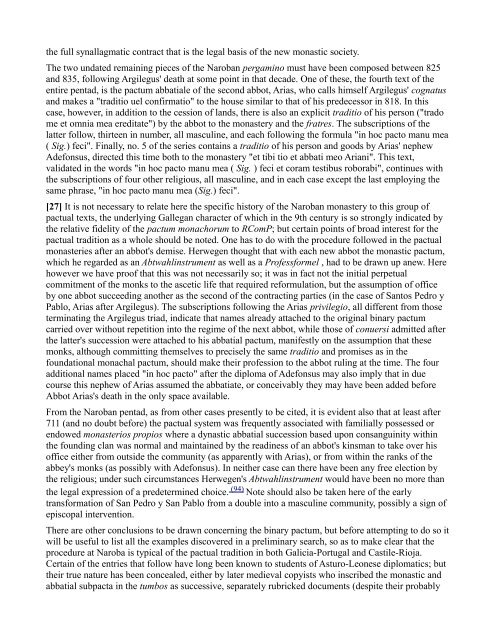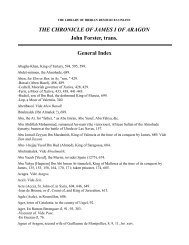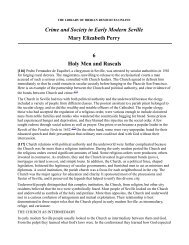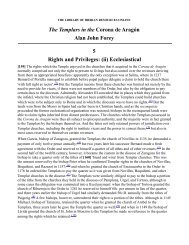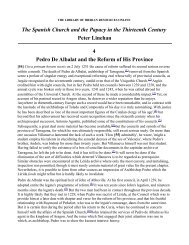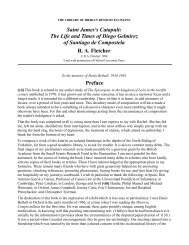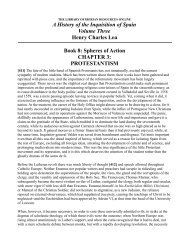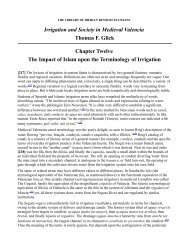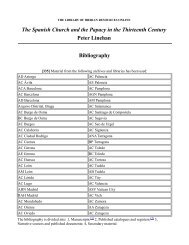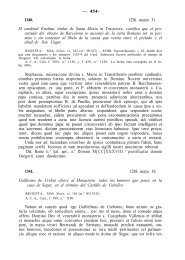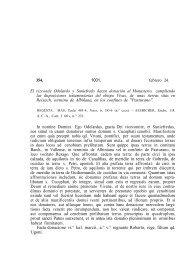The Pactual Tradition in Hispanic Monasticism - The Library of ...
The Pactual Tradition in Hispanic Monasticism - The Library of ...
The Pactual Tradition in Hispanic Monasticism - The Library of ...
Create successful ePaper yourself
Turn your PDF publications into a flip-book with our unique Google optimized e-Paper software.
the full synallagmatic contract that is the legal basis <strong>of</strong> the new monastic society.<br />
<strong>The</strong> two undated rema<strong>in</strong><strong>in</strong>g pieces <strong>of</strong> the Naroban pergam<strong>in</strong>o must have been composed between 825<br />
and 835, follow<strong>in</strong>g Argilegus' death at some po<strong>in</strong>t <strong>in</strong> that decade. One <strong>of</strong> these, the fourth text <strong>of</strong> the<br />
entire pentad, is the pactum abbatiale <strong>of</strong> the second abbot, Arias, who calls himself Argilegus' cognatus<br />
and makes a "traditio uel confirmatio" to the house similar to that <strong>of</strong> his predecessor <strong>in</strong> 818. In this<br />
case, however, <strong>in</strong> addition to the cession <strong>of</strong> lands, there is also an explicit traditio <strong>of</strong> his person ("trado<br />
me et omnia mea ereditate") by the abbot to the monastery and the fratres. <strong>The</strong> subscriptions <strong>of</strong> the<br />
latter follow, thirteen <strong>in</strong> number, all mascul<strong>in</strong>e, and each follow<strong>in</strong>g the formula "<strong>in</strong> hoc pacto manu mea<br />
( Sig.) feci". F<strong>in</strong>ally, no. 5 <strong>of</strong> the series conta<strong>in</strong>s a traditio <strong>of</strong> his person and goods by Arias' nephew<br />
Adefonsus, directed this time both to the monastery "et tibi tio et abbati meo Ariani". This text,<br />
validated <strong>in</strong> the words "<strong>in</strong> hoc pacto manu mea ( Sig. ) feci et coram testibus roborabi", cont<strong>in</strong>ues with<br />
the subscriptions <strong>of</strong> four other religious, all mascul<strong>in</strong>e, and <strong>in</strong> each case except the last employ<strong>in</strong>g the<br />
same phrase, "<strong>in</strong> hoc pacto manu mea (Sig.) feci".<br />
[27] It is not necessary to relate here the specific history <strong>of</strong> the Naroban monastery to this group <strong>of</strong><br />
pactual texts, the underly<strong>in</strong>g Gallegan character <strong>of</strong> which <strong>in</strong> the 9th century is so strongly <strong>in</strong>dicated by<br />
the relative fidelity <strong>of</strong> the pactum monachorum to RComP; but certa<strong>in</strong> po<strong>in</strong>ts <strong>of</strong> broad <strong>in</strong>terest for the<br />
pactual tradition as a whole should be noted. One has to do with the procedure followed <strong>in</strong> the pactual<br />
monasteries after an abbot's demise. Herwegen thought that with each new abbot the monastic pactum,<br />
which he regarded as an Abtwahl<strong>in</strong>strument as well as a Pr<strong>of</strong>essformel , had to be drawn up anew. Here<br />
however we have pro<strong>of</strong> that this was not necessarily so; it was <strong>in</strong> fact not the <strong>in</strong>itial perpetual<br />
commitment <strong>of</strong> the monks to the ascetic life that required reformulation, but the assumption <strong>of</strong> <strong>of</strong>fice<br />
by one abbot succeed<strong>in</strong>g another as the second <strong>of</strong> the contract<strong>in</strong>g parties (<strong>in</strong> the case <strong>of</strong> Santos Pedro y<br />
Pablo, Arias after Argilegus). <strong>The</strong> subscriptions follow<strong>in</strong>g the Arias privilegio, all different from those<br />
term<strong>in</strong>at<strong>in</strong>g the Argilegus triad, <strong>in</strong>dicate that names already attached to the orig<strong>in</strong>al b<strong>in</strong>ary pactum<br />
carried over without repetition <strong>in</strong>to the regime <strong>of</strong> the next abbot, while those <strong>of</strong> conuersi admitted after<br />
the latter's succession were attached to his abbatial pactum, manifestly on the assumption that these<br />
monks, although committ<strong>in</strong>g themselves to precisely the same traditio and promises as <strong>in</strong> the<br />
foundational monachal pactum, should make their pr<strong>of</strong>ession to the abbot rul<strong>in</strong>g at the time. <strong>The</strong> four<br />
additional names placed "<strong>in</strong> hoc pacto" after the diploma <strong>of</strong> Adefonsus may also imply that <strong>in</strong> due<br />
course this nephew <strong>of</strong> Arias assumed the abbatiate, or conceivably they may have been added before<br />
Abbot Arias's death <strong>in</strong> the only space available.<br />
From the Naroban pentad, as from other cases presently to be cited, it is evident also that at least after<br />
711 (and no doubt before) the pactual system was frequently associated with familially possessed or<br />
endowed monasterios propios where a dynastic abbatial succession based upon consangu<strong>in</strong>ity with<strong>in</strong><br />
the found<strong>in</strong>g clan was normal and ma<strong>in</strong>ta<strong>in</strong>ed by the read<strong>in</strong>ess <strong>of</strong> an abbot's k<strong>in</strong>sman to take over his<br />
<strong>of</strong>fice either from outside the community (as apparently with Arias), or from with<strong>in</strong> the ranks <strong>of</strong> the<br />
abbey's monks (as possibly with Adefonsus). In neither case can there have been any free election by<br />
the religious; under such circumstances Herwegen's Abtwahl<strong>in</strong>strument would have been no more than<br />
the legal expression <strong>of</strong> a predeterm<strong>in</strong>ed choice. (94) Note should also be taken here <strong>of</strong> the early<br />
transformation <strong>of</strong> San Pedro y San Pablo from a double <strong>in</strong>to a mascul<strong>in</strong>e community, possibly a sign <strong>of</strong><br />
episcopal <strong>in</strong>tervention.<br />
<strong>The</strong>re are other conclusions to be drawn concern<strong>in</strong>g the b<strong>in</strong>ary pactum, but before attempt<strong>in</strong>g to do so it<br />
will be useful to list all the examples discovered <strong>in</strong> a prelim<strong>in</strong>ary search, so as to make clear that the<br />
procedure at Naroba is typical <strong>of</strong> the pactual tradition <strong>in</strong> both Galicia-Portugal and Castile-Rioja.<br />
Certa<strong>in</strong> <strong>of</strong> the entries that follow have long been known to students <strong>of</strong> Asturo-Leonese diplomatics; but<br />
their true nature has been concealed, either by later medieval copyists who <strong>in</strong>scribed the monastic and<br />
abbatial subpacta <strong>in</strong> the tumbos as successive, separately rubricked documents (despite their probably


